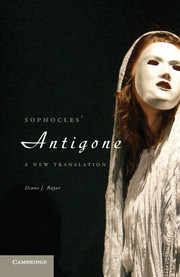Note from a Stage Director
Published online by Cambridge University Press: 05 June 2012
Summary
How do you produce a piece of classical theatre in a way that is relevant and provocative for a modern audience? I confronted this question while directing the inaugural production of Diane Rayor's newly translated Antigone, and the answers we (my cast of university actors and I) came up with resulted in a satisfying and engaging piece of theater for audience and cast members alike. The two concerns that seemed most relevant to our work as a university theater program were (1) making a story, well-known to its original Greek viewers, just as easy to understand for its twenty-first-century audience and (2) engaging the audience with the classical theatrical conventions of the Messenger and Chorus in innovative ways.
Antigone begins after Oedipus' death and the war in which Antigone's brothers kill each other. The Greek audience of 440s bce would have known the family relationships and basic events surrounding the Theban cycle as well as many of my students know the story of Jesus. You can put dramaturgical notes in the program to help a modern audience get up to speed, but many audience members will not have the time or interest to read the notes before they see the play. Nor did we want to add a prologue, as we had seen in other productions. Instead, we addressed this issue of lack of familiarity by incorporating a family tree as the backdrop flat of our play.
- Type
- Chapter
- Information
- Sophocles' AntigoneA New Translation, pp. 65 - 68Publisher: Cambridge University PressPrint publication year: 2011



